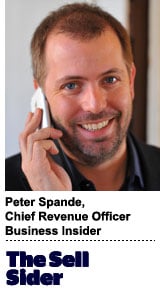 “The Sell Sider” is a column written by the sell side of the digital media community.
“The Sell Sider” is a column written by the sell side of the digital media community.
Today’s column is written by Peter Spande, chief revenue officer at Business Insider.
Two years ago, Tim Armstrong co-opted the expression “barbell strategy” to describe AOL’s approach to balancing programmatic with direct sales. On one side of the barbell is the publisher’s programmatic business. On the other, its marketing services and custom executions.
Connecting both sides of the business was not as important and received much less attention. But that’s changing. The best-positioned publishers are those that do the finest job connecting the two sides of the barbell.
When Armstrong introduced the expression, the barbell analogy helped describe how RTB and direct sales could coexist and even complement one another. At the time, this acknowledged coexistence was a big deal. Many publishers were trying to put the programmatic genie back in the bottle and the idea of a strong two-prong strategy was relatively new and, until then, rarely discussed.
In the intervening years, the strategy has proven very successful for AOL and others. Most publishers became very comfortable with the programmatic genie. For some, programmatic became the center of monetization strategies, rather than the sweeper following behind, dealing with unsold excess.
The other side of the barbell has also evolved. Whether called native solutions, content marketing or simply custom programs, the industry is pushing the envelope and developing a wide variety of solutions. Experimentation and innovation in the creative and marketing services side of the business create new and exciting ways to connect advertisers with audiences and allow brands to tap into the unique properties of individual sites.
This leads me to the bar that connects the two ends of the barbell. For the most part, programmatic and custom solutions exist in separate spheres today. Often those spheres have no connection whatsoever. Different buyers, teams and KPIs all lead publishers to comfortably keep these disciplines in separate corners of their business. Many publishers have completely separate operations, sales and goals for these two sides of the barbell.
But the most advanced marketers are now asking for these two sides of the business to work together. The rest of the industry will follow quickly. This drives huge implications for publishers.
Data-Driven Native
The programmatic side of the house takes data targeting for granted. As the number and variety of custom, native and content programs increases, the promotion for these programs must also evolve. The data that now powers many direct sales, and nearly all programmatic media, will start playing an important role in custom programs.
Programmatic Guaranteed
It goes by many names: programmatic guaranteed, automated guaranteed or programmatic direct. As the systems that serve programmatic become able to buy and serve guaranteed inventory, the buyers of custom programs will work with or become the buyers of programmatic. Given the importance of guaranteed inventory on custom solutions, this is a real game-changer.
Blurred Lines
The buy side is changing how it operates. Huge shifts in buying strategy and tactics will force publishers to rework their monetization strategies.
As a result, some brands are developing in-house programmatic buying services. DSPs and programmatic agencies are starting to buy guaranteed inventory and other creative services. Some media agencies are eliminating trading desks and executing their programmatic strategy as a part of the overall media buy. If you want your business to operate smoothly, you will need to connect the two sides.
The bottom line: As programmatic gets more sophisticated, so too do publishers when it comes to rethinking their traditional ways of selling ads. Publishers will need to connect the two sides of the barbell.
But while the integration of both sides of the sales spectrum can be painful in the short term, in the end, it’s worth it. Just like lifting real barbells.
Follow Peter Spande (@PeteSpande), Business Insider (@businessinsider) and AdExchanger (@adexchanger) on Twitter.












